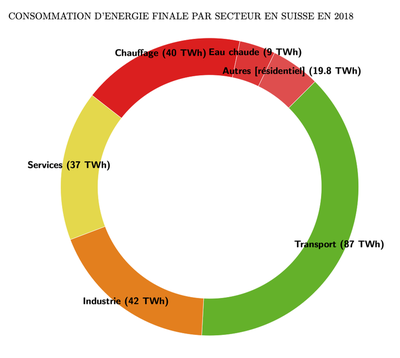How much energy does Switzerland consume? For what purposes?
Switzerland consumes about 230 TWh of final energy per year. One-third is used to cover our transportation needs, mainly through petroleum products, with a smaller proportion of electricity and a marginal contribution from natural gas. Another third meets our heating needs, mainly with oil or natural gas, but with a significant proportion of wood and electricity. The last third is used to produce domestic hot water and heat for industry, as well as to power our lamps and electrical and electronic appliances with electricity. Electricity, which is used in all applications, accounted for 25% (57 TWh) of our final energy consumption in 2018.
“Final” energy, or “distributed” energy, is the energy purchased by the consumer (petrol, oil, natural gas, wood pellets, electricity, etc.). To make this final energy available to the consumer, we need to use “primary” energy sources (crude oil, coal, natural gas, uranium ore, natural wood, hydropower, solar radiation, wind energy, and so on) to transform them into “final” energy (by refining oil, conversion into electricity, and so on) and deliver it to the user. These transformations and routing generate losses. Thus, in the current energy system, we consume 295 TWh of primary energy annually to obtain the approximately 230 TWh of final energy we need. Our final energy consumption increased between 1990 and 2018 by about 5%, but fluctuated between 230 and 250 TWh over the period 2010-2018. It is the household sector that contributes the most to this growth: + 10%, despite better building insulation and more efficient heating systems.
Our energy needs are divided relatively equally among households, industry and services, and transport [→ see figure below].Households consume an average of 60 to 65 TWh of final energy per year,which in 2018 accounted for 27% of the country’s final energyconsumption. More than 70% is used to heat buildings (50 TWh) andproduce domestic hot water (10 TWh). Other uses include household andelectronic appliances, and lighting. Despite their large number, allthese devices collectively account for only 8 to 9 TWh, or 16% of totalelectricity consumption [→ Q8]. This corresponds to 3.8% of the Swiss final energy consumption.
Given the importance of heating, does this mean that only efforts in this sector can drastically reduce our energy consumption? No, for two reasons. On the one hand, boilers have a high average service life (20 years) and therefore a low replacement rate. Measures to make savings in this sector therefore take time to produce effects… while we are in a hurry. On the other hand, the multiplication of small savings can ultimately bring substantial cumulative results. Any saved TWh remains a good thing when it comes to replacing five nuclear power plants.

References
- Kemmler, Spillmann & Koziel (2018)
- Kemmler, A., Spillmann, T. & Koziel, S. (2018). Ex-post-analyse des schweizerischen energieverbrauchs 2000-2017 nach bestimmungsfaktoren. Office fédéral de l'énergie (OFEN).
- Kemmler, A and Koziel, S and Wüthrich, P and Notter, B and Keller, M and Jakob, M and Catenazzi, G (2017)
- Kemmler, A and Koziel, S and Wüthrich, P and Notter, B and Keller, M and Jakob, M and Catenazzi, G (2017). Analyse des schweizerischen Energieverbrauchs 2000-2016 nach Verwendungszwecken. Office fédéral de l'énergie (OFEN).
- Office fédéral de l'énergie (OFEN) (2019)
- Office fédéral de l'énergie (OFEN) (2019). Statistique globale de l’énergie 2018. OFEN.
- Office fédéral de la statistique (OFS) (2019)
- Office fédéral de la statistique (OFS) (2019). Energie: Panorama. OFS.